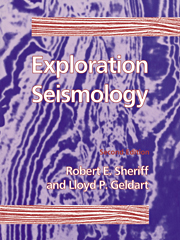Book contents
- Frontmatter
- Contents
- Preface
- Mathematical conventions and symbols
- 1 Introduction
- 2 Theory of seismic waves
- 3 Partitioning at an interface
- 4 Geometry of seismic waves
- 5 Seismic velocity
- 6 Characteristics of seismic events
- 7 Equipment
- 8 Reflection field methods
- 9 Data Processing
- 10 Geologic interpretation of reflection data
- 11 Refraction methods
- 12 3-D Methods
- 13 Specialized techniques
- 14 Specialized applications
- 15 Background mathematics
- Appendices
- Index
10 - Geologic interpretation of reflection data
Published online by Cambridge University Press: 05 June 2012
- Frontmatter
- Contents
- Preface
- Mathematical conventions and symbols
- 1 Introduction
- 2 Theory of seismic waves
- 3 Partitioning at an interface
- 4 Geometry of seismic waves
- 5 Seismic velocity
- 6 Characteristics of seismic events
- 7 Equipment
- 8 Reflection field methods
- 9 Data Processing
- 10 Geologic interpretation of reflection data
- 11 Refraction methods
- 12 3-D Methods
- 13 Specialized techniques
- 14 Specialized applications
- 15 Background mathematics
- Appendices
- Index
Summary
Overview
Interpretation, as we use the word in this chapter, involves determining the geologic significance of seismic data. This necessarily involves geologic terminology and we follow the usage in Bates and Jackson (1987). Interpretation also sometimes includes data reduction, selecting events believed to be primary reflections, and locating the reflectors with which they are associated. Indeed, a number of decisions have to be made in data processing, acquisition, and even in the initial planning of a survey that prejudice the geologic conclusions and thus could be legitimately included as part of interpretation.
There are few books that concentrate on the geologic interpretation of seismic data; we cite Fitch (1976); Anstey (1977, 1980a, 1980b); Sheriff (1980); McQuillin, Bacon, and Barclay (1984); Badley and Anstey (1984); Badley (1985); Gries and Dyer (1985); and Brown (1991). Numerous scientific sections and their structural/stratigraphic interpretations are shown in Bally (1983-4, 1987-9). A number of interpretation papers are published in The Leading Edge, and the Society of Exploration Geophysicists periodically publishes reprints of these (SEG, 1989–92).
It is rare that the correctness or incorrectness of an interpretation can be ascertained because the actual geology is rarely ever known in adequate detail. The test of a good interpretation is consistency rather than correctness (Anstey, 1973). Not only must a good interpretation be consistent with all the seismic data, it also must be consistent with all that is known about the area, including gravity and magnetic data, well information and surface geology, as well as geologic and physical concepts.
- Type
- Chapter
- Information
- Exploration Seismology , pp. 349 - 424Publisher: Cambridge University PressPrint publication year: 1995
- 3
- Cited by



